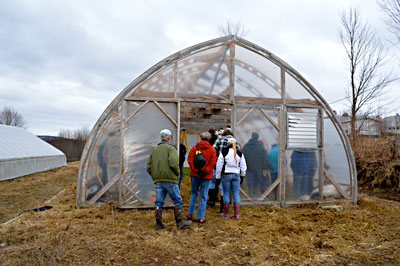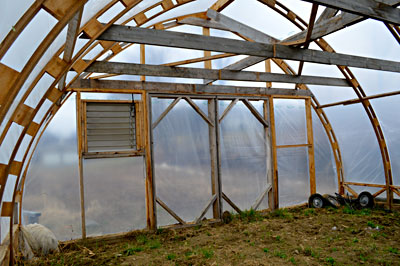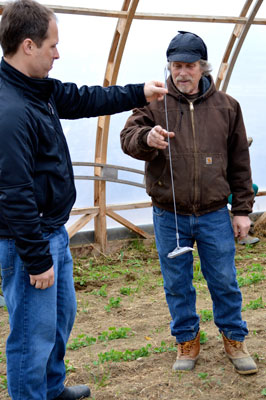 |
|
| This 22- by 49-foot high tunnel at Stutzman’s Farm in Sangerville is made from native white cedar, using an innovative design by Sunny Stutzman. | |
 |
|
| Detail of the structure. | |
 |
 |
| Two side vents – one at each end of the house – are gas-powered and can be set to open at a specific temperature. | Close-up of a side vent. |
 |
 |
| The combination of end vents and skylights means no roll-up sides are necessary. | Wheels can be attached to shafts along the base of the high tunnel to move it. |
 |
 |
| Sunny (left) and Sid show a duckbill, used to anchor the house in the soil. | Air is blown between the double poly covering for added insulation. |
 |
|
| Sunny (left), Rainie and Sid Stutzman in their award-winning restaurant. | |
Text and photos by Jean English
An April 2014 field day in Sangerville, Maine, featured a novel high tunnel made with local materials that should boost not only the economy of area farms and gardens but that of Piscataquis County’s wood products and manufacturing industries as well.
The Stutzman’s Farm tour was sponsored by the Piscataquis County Soil and Water Conservation District (PCSWCD) in partnership with MOFGA and was made possible through a 2011 USDA Natural Resources Conservation Service (NRCS) Conservation Innovation Grant (number 69-1218-11-25) that funded the innovative wooden high tunnel design, construction and testing.
Sid Stutzman grew up on the farm, which his grandfather started. Sid and his wife, Rainie, have operated the farm together for 36 years and raised their children there. The Stutzmans grow produce in tunnels and in the field to sell at their on-site Farm to Table Bakery and Café. They noted that frost can occur until June 10 in their location – so high tunnels are especially valuable for them. (This spring Yankee Magazine named Stutzman’s Farm Stand the Best Farm-to-Fork Restaurant in Maine – see https://www.yankeemagazine.com/article/pressroom/yankee-magazine-names-local-maine-establishments-to-2014-editors-choice-list)
Sid and Rainie’s son Sunny, an industrial designer with Sunny Skies Design, designed the 22- by 49-foot high tunnel for the PCSWCD, and it was tested for structural integrity by the University of Maine Advanced Engineered Wood Composites Center. It is based on a design by Virginia Polytech that used cypress, but Sunny substituted locally available white cedar (Thuja occidentalis).
“We had to do new calculations for white cedar,” said Sunny. Also, because 1-inch-thick cedar can’t be bent into the Gothic arch shape without breaking, he had to screw and glue together two pieces of ½-inch x 2-inch lath. He also added trusses to the structure to handle Maine’s snow loads and wind and to make the house stiffer for moving.
This is not the first tunnel on the farm; the growers also have a Ledgewood (www.ledgewoodfarm.com).
Sunny’s high tunnel has been tested for structural integrity and suitability for small farm use. It sheds snow better than their Ledgewood. (Some Ledgewood houses, with a steeper pitch, do shed snow well.) Twelve duckbills, which work like toggle bolts, anchor the house in the soil and help it withstand 80 mph winds.
The house is drier than their Ledgewood, as its double poly covering creates less condensation. The system used to inflate the two layers of poly could be run off a small photovoltaic fan, said Sunny.
The tunnel needs much less attention in terms of rolling up the sides and running expensive exhaust fans than their Ledgewood, as it has two gas-operated end vents and four “skylights” that can be set to open at a desired temperature. The skylights create a chimney effect, drawing out hot air. Sunny joked that for the first time in 36 years, his parents can drive to Bangor during the growing season.
Wheels can be attached to shafts at the base of the tunnel to make the structure portable so that soil can be exposed to rain and snow after several seasons of use, helping prevent salt buildup.
The tunnel uses only passive heat from the sun to warm the soil; crops are grown in the ground.
The PCSWCD is collaborating with natural resource consultant and soil specialist Susan Watson to evaluate agricultural conservation practices and soil ecosystem improvements associated with use of the tunnel, as well as affordability and usability of the tunnel.
The PCSWCD plans to work with its partnering agencies to develop local manufacturing and marketing of the patent-pending tunnel. It hopes to have these low-cost high tunnels deemed acceptable to use with NRCS cost-sharing programs and to create plans, a kit and a handbook for farmers and gardeners who would like to grow crops in such a high tunnel.
During the tour, the Stutzmans noted other conservation practices they use, including zone tillage, which has led to increased soil organic matter every year and has reduced soil amendment needs by 50 percent; making their own compost; growing strawberries on raised beds; and transitioning one field, which grows primarily lettuce and carrots, to MOFGA certified organic production.
Regarding strawberries, Sid noted the 50-50 chance of having strawberry plants survive the winter in their harsh northern climate. By growing the crop on 8-inch-high, south facing, black plastic-covered raised beds, they hope to beat those odds. They grow oats between the beds, so they no longer use herbicides there.
The high tunnel design, building and testing was supported by USDA NRCS under number 69-1218-11-25.
For more information on the USDA NRCS Seasonal High Tunnel financial assistance program, see “Seasonal High Tunnels for Food and Other Specialty Crop Production,” USDA NRCS, Maine, March 2013, https://www.nrcs.usda.gov/Internet/FSE_DOCUMENTS/stelprdb1082623.pdf
For more about the Piscataquis County Soil and Water Conservation District technical assistance and education programs, contact Joanna Tarrazi, Kacey Weber or Lynn Lubas at [email protected].
